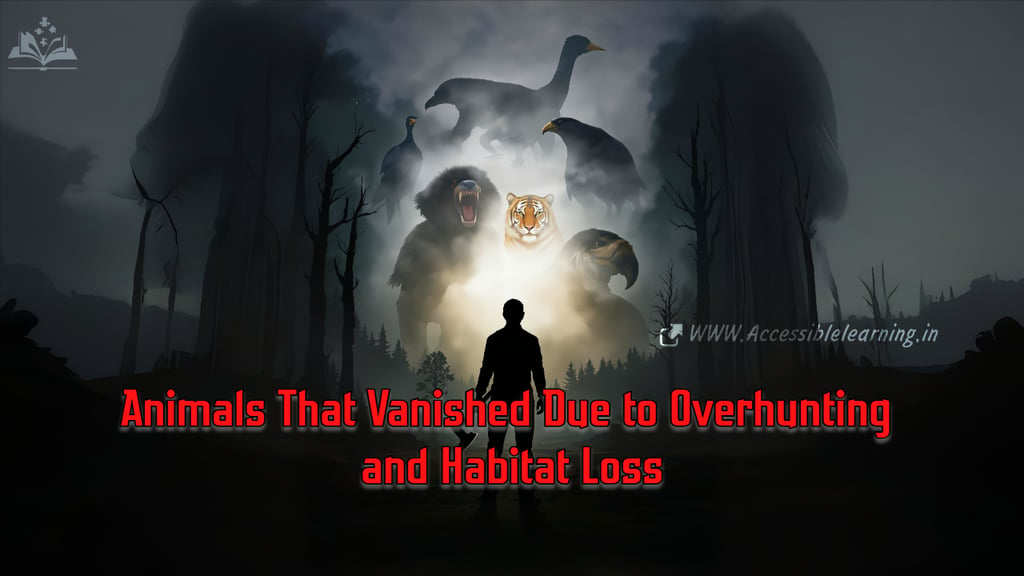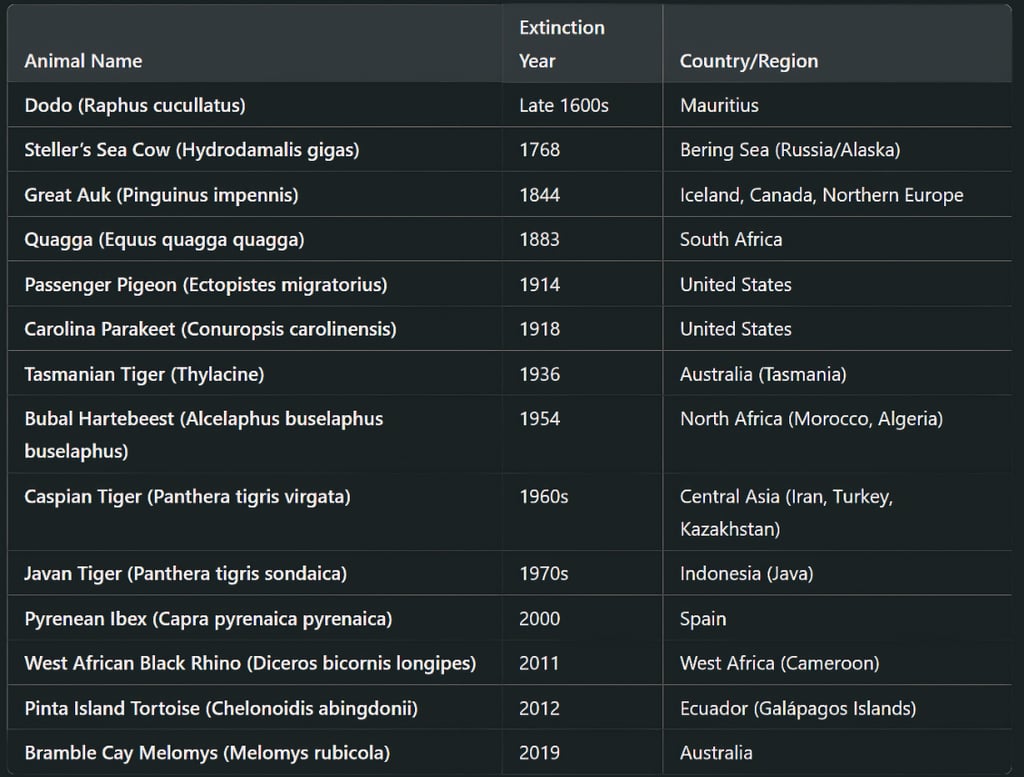
Extinct Animals: How Humans Have Erased Biodiversity
Human activities have driven many remarkable species to extinction, altering ecosystems and reducing biodiversity. This in-depth article explores extinct animals caused by humans, their ecological impact, and how we can prevent future extinctions through conservation efforts.
ENVIRONMENTHARSH REALITYAWARE/VIGILANTGLOBAL ISSUES
Sachin K Chaurasiya
2/28/20256 min read


Throughout history, humans have significantly influenced the planet’s biodiversity. While some species have gone extinct due to natural causes, human activities such as habitat destruction, overhunting, climate change, and pollution have accelerated extinction rates. Many remarkable species have vanished forever due to direct or indirect human interference, altering ecosystems and reducing biodiversity. This article explores notable animals that became extinct due to human actions and the consequences of their disappearance.
The Dodo (Raphus cucullatus)
Extinct: Late 1600s
One of the most famous cases of human-caused extinction, the dodo, was a flightless bird native to Mauritius. With no natural predators, the dodo thrived until Dutch sailors arrived in the 1600s. Hunting, habitat destruction, and the introduction of invasive species such as rats and monkeys led to its rapid extinction. The dodo’s demise highlights the devastating impact of human intervention on isolated species.
Ecological Role and Legacy
The dodo played a vital role in dispersing seeds of native plants. Its extinction led to cascading effects on the island’s ecosystem. Today, the dodo serves as a symbol of conservation awareness, reminding humanity of the consequences of unchecked exploitation.


The Passenger Pigeon (Ectopistes migratorius)
Extinct: 1914
Once numbering in the billions, passenger pigeons were among North America’s most abundant birds. However, mass hunting and habitat destruction led to a catastrophic population decline. The last known individual, named Martha, died in captivity at Cincinnati Zoo in 1914. The extinction of the passenger pigeon serves as a stark reminder of the consequences of overexploitation.
Role in Ecosystem
Passenger pigeons played a crucial role in forest regeneration by dispersing seeds and maintaining tree diversity. Their extinction altered forest compositions, impacting other species dependent on these habitats.
The Tasmanian Tiger (Thylacine)
Extinct: 1936
The thylacine, also known as the Tasmanian tiger, was a carnivorous marsupial native to Australia, Tasmania, and New Guinea. European settlers perceived it as a threat to livestock and hunted it to extinction. The last known thylacine died in captivity in 1936 at the Hobart Zoo in Tasmania. Despite occasional unverified sightings, no confirmed evidence of its survival exists.
Efforts to Revive the Species
Scientists are currently exploring de-extinction efforts using preserved genetic material. Advances in cloning and CRISPR gene editing technology could potentially bring back thylacine in the future.
The Great Auk (Pinguinus impennis)
Extinct: 1844
The great auk, a flightless seabird, was once widespread across the North Atlantic. Overhunting for feathers, meat, and eggs led to its rapid decline. The last two known individuals were killed in Iceland in 1844. The great auk’s extinction is a significant loss, as it played an essential role in marine ecosystems.
Impact on Marine Food Chain
As a key predator of fish, the great auk’s disappearance affected marine food webs. Their extinction disrupted populations of prey species and predators reliant on auk colonies.
The Pyrenean Ibex (Capra pyrenaica pyrenaica)
Extinct: 2000 (briefly revived in 2003)
Native to the Iberian Peninsula, the Pyrenean ibex was driven to extinction due to hunting and habitat loss. In a groundbreaking scientific effort, a cloned Pyrenean ibex was born in 2003, making it the first extinct species to be briefly resurrected. Unfortunately, the clone survived only a few minutes due to lung defects, emphasizing the challenges of de-extinction science.
Lessons from Cloning Attempts
This effort provided valuable insights into cloning extinct species, paving the way for future attempts to restore lost biodiversity.
Steller’s Sea Cow (Hydrodamalis gigas)
Extinct: 1768
Discovered in 1741 by explorers in the Bering Sea, Steller’s sea cow was a massive marine mammal related to the manatee. Within 27 years of its discovery, it was hunted to extinction for its meat, fat, and hide. This rapid disappearance showcases how human greed can drive species to extinction in an incredibly short period.
Role in Marine Ecosystems
As a herbivore, Steller’s sea cow helped regulate kelp forest growth. Its extinction led to unchecked sea urchin populations, contributing to kelp decline in some areas.


The Carolina Parakeet (Conuropsis carolinensis)
Extinct: 1918
As one of the only native parrot species in the United States, the Carolina parakeet was once widespread. However, habitat destruction, hunting, and the pet trade led to its extinction. The last known bird died in captivity in 1918, marking the loss of a vibrant species that played an essential role in seed dispersal.
Environmental Impact
With the Carolina parakeet gone, certain plant species lost an important seed disperser, leading to changes in regional vegetation dynamics.


FAQs on Extinct Animals by Humans
What are some animals that went extinct due to human activities?
Several species have gone extinct due to human actions, including the dodo, passenger pigeon, Tasmanian tiger, great auk, Steller’s sea cow, Carolina parakeet, Pyrenean ibex, and many more. These extinctions resulted from overhunting, habitat destruction, climate change, and invasive species introduction.
What was the main reason for the extinction of the dodo?
The dodo, native to Mauritius, became extinct due to overhunting by sailors, habitat destruction, and the introduction of invasive species such as rats and monkeys, which ate their eggs. The last confirmed sighting was in the late 1600s.
Why did the passenger pigeon go extinct despite its large population?
Passenger pigeons were once the most abundant bird species in North America, but excessive hunting for meat, deforestation, and habitat loss led to their rapid decline. The last known passenger pigeon, named Martha, died in captivity in 1914.
Can extinct animals be brought back to life?
Scientists are working on de-extinction projects using DNA samples, cloning, and gene-editing technology. The Pyrenean ibex was briefly revived in 2003, but the clone survived only a few minutes. Other efforts are ongoing for species like the Tasmanian Tiger and woolly Mammoth.
How does the extinction of an animal affect the ecosystem?
When a species goes extinct, it disrupts the food chain and alters ecosystems. For example, Steller’s sea cow helped regulate kelp forests, and passenger pigeons aided in forest regeneration. Their loss can lead to cascading ecological consequences.
What is the role of humans in preventing future extinctions?
Humans can prevent extinctions by protecting habitats, supporting conservation programs, reducing pollution, enforcing anti-poaching laws, and promoting sustainable practices such as responsible hunting and deforestation control.
Which species are currently at risk of human-caused extinction?
Many species are critically endangered due to human activities, including the Javan rhino, vaquita porpoise, pangolin, and Amur leopard. Conservation efforts are crucial to preventing them from meeting the same fate as extinct species.
What is the most recent animal to go extinct due to human impact?
The Bramble Cay melomys, a rodent native to Australia, was declared extinct in 2019 due to rising sea levels caused by climate change. It is considered the first mammal to go extinct due to human-driven climate change.
How does hunting contribute to animal extinction?
Unregulated hunting and poaching can decimate animal populations. Species like the Tasmanian tiger and passenger pigeon were wiped out due to excessive hunting, while animals like the rhinoceros and elephants are still threatened by poaching for their horns and tusks.
How can I contribute to animal conservation?
You can help by supporting wildlife conservation organizations, reducing plastic waste, avoiding products made from endangered species, spreading awareness, and advocating for stronger environmental laws to protect at-risk species.


The Impact of Human-Caused Extinctions
Loss of Biodiversity: Each extinct species played a role in its ecosystem, and their disappearance can cause imbalances.
Disruption of Food Chains: Many extinct animals were key predators or prey, affecting populations of other species.
Loss of Potential Scientific Discoveries: Extinct species could have provided insights into medicine, genetics, and ecology.
Cultural and Historical Loss: Many cultures revered or depended on now-extinct animals, altering traditions and lifestyles.
How Can We Prevent Further Extinctions?
Conservation Efforts: Supporting wildlife conservation programs and protected areas can help preserve endangered species.
Sustainable Practices: Reducing deforestation, overfishing, and poaching can prevent habitat destruction and species decline.
Education and Awareness: Promoting knowledge about endangered species encourages responsible behavior and policy-making.
Technology and Scientific Research: Advances in genetic preservation and cloning may help restore lost species or protect critically endangered ones.
Human activities have driven many incredible species to extinction, leaving a void in the natural world. While we cannot undo the past, we must learn from these losses and take action to protect the species that remain. By prioritizing conservation and sustainable practices, we can prevent further extinctions and ensure that future generations inherit a biodiverse and thriving planet.
Subscribe To Our Newsletter
All © Copyright reserved by Accessible-Learning Hub
| Terms & Conditions
Knowledge is power. Learn with Us. 📚


